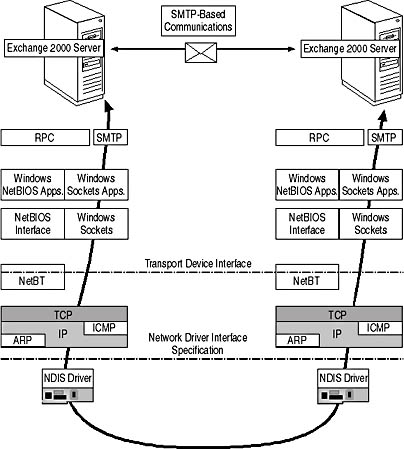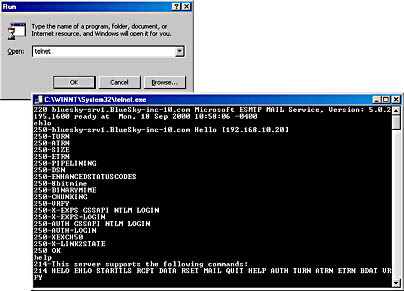Lesson 3: Windows 2000 Protocols and Services Integration
TCP/IP is Microsoft's strategic network transport protocol. Exchange 2000 Server integrates tightly with Active Directory, and Active Directory requires DNS, which in turn requires TCP/IP. Therefore, you may consider Exchange 2000 primarily a TCP/IP-based system, although it can also use other networking protocols (such as Internetwork Packet Exchange/Sequenced Packet Exchange [IPX/SPX], AppleTalk, Banyan Vines protocol). In fact, focusing on TCP/IP makes it easy to integrate Exchange 2000 into any PC-based environment. In addition, Windows 2000 Server protocols and services, such as IP Security (IPSec) and Kerberos, allow you to operate securely over TCP/IP networks. Windows 2000 also provides application layer components, such as the SMTP and Network News Transfer Protocol (NNTP) services, which the Exchange 2000 Setup program extends to provide the functionality required for an enterprise-class messaging and collaboration system.
In this lesson, you will read about the network infrastructure of Windows 2000 that Exchange 2000 relies on for its own communication purposes. This lesson focuses on those aspects relevant to the communication between Outlook 2000 and Exchange 2000 Server and the communication between Exchange 2000 servers themselves.
At the end of this lesson, you will be able to:
- Describe how Outlook 2000 and Exchange 2000 utilize the Windows 2000 network infrastructure.
- Identify information services of Windows 2000 used for Exchange 2000 server-to-server communication.
- Describe extensions added to Windows 2000 information services for Exchange 2000 server-to-server communication.
Estimated time to complete this lesson: 60 minutes
Windows 2000 Network Architecture
Messaging systems rely heavily on the underlying communication infrastructure for client-to-server and server-to-server data transfer. Exchange 2000 Server is no exception and utilizes a number of high-level interfaces to access network resources, such as RPCs and Windows Sockets. You can find further information about RPCs and Windows Sockets in Chapter 3, "Microsoft Exchange 2000 Server Architecture."
TCP/IP Protocol Suite
The Internet has proven that the TCP/IP protocol suite is the right choice for computer networks of any size and purpose. Choose TCP/IP and don't deploy any other network protocol if you don't have to. Most, if not all, modern network systems support TCP/IP. It is advisable to configure your workstations and servers for only one protocol stack because this minimizes configuration overhead and resource consumption and maximizes network performance.
MAPI-Based Clients
MAPI-based clients, such as Outlook 2000, depend on synchronous RPCs. In a TCP/IP-only environment, the Outlook client attempts to connect to the Exchange 2000 server via TCP/IP and the RPC-based communication is handled via Windows Sockets (see Figure 2.9). You can read more about RPCs in respect to non-TCP/IP environments in Chapter 10, "MAPI-Based Clients in a Novell NetWare Environment."

Figure 2.9 RPC-based communication
Server-to-Server Communication
Windows Sockets is also utilized for server-to-server communication. Servers running Exchange 2000 Server transfer messages preferably via SMTP, which requires the Windows Sockets interface (see Figure 2.10).
Unlike earlier versions of Exchange Server, which used synchronous RPCs for server-to-server communication within sites, Exchange 2000 Server does not rely on RPCs between servers. Instead, SMTP is used. As an asynchronous transport protocol, SMTP allows Exchange 2000 Server to operate well under high- and low-bandwidth network conditions. RPC-based server-to-server communication, on the other hand, is only important when connecting Exchange 2000 Server to previous Exchange Server versions as outlined in Chapter 6, "Coexistence with Previous Microsoft Exchange Server Versions."

Figure 2.10 SMTP-based communication
Internet Information Services 5.0
Exchange 2000 Server takes advantage of the SMTP and NNTP services that ship with Internet Information Services (IIS) 5.0. IIS 5.0 is installed by default as a networking service of Windows 2000 Server. Exchange 2000 extends the SMTP and NNTP services to implement Exchange-specific functionality. You can read more about the extension of the IIS in the later section, "Exchange 2000 Server Extensions."
Native Message Transport Protocol
SMTP is Exchange 2000 Server's native messaging transport protocol. If two or more Exchange 2000 servers exist in your environment, they will detect each other via Active Directory and route messages to one another directly using SMTP (see Figure 2.11).
Exchange 2000 uses the SMTP service to perform the following functions:
- Accept messages from SMTP-based messaging systems (and Internet-based clients) for transfer and delivery to one or more recipients in the Exchange 2000 organization.
- Determine whether any recipients reside on the local Exchange 2000 server and, if so, deliver the messages to each recipient's mailbox.
- Relay messages for recipients on other servers on the network to the appropriate SMTP service according to the routing plan.
- Relay messages for recipients outside the Exchange 2000 organization to the appropriate service or gateway queue so that the messages are eventually delivered to the appropriate recipients.

Figure 2.11 Native message transfer between Exchange 2000 servers

Exercise 4: Checking the SMTP Service
In this exercise you will verify the version of the SMTP service running on an Exchange 2000 computer and the specific SMTP verbs it supports. This emphasizes that Exchange 2000 does not provide its own SMTP transfer service for its native communication but relies on the component that actually comes with Windows 2000.

To view a multimedia demonstration that displays how to perform this procedure, run the EX4CH2.AVI files from the \Exercise_Information\ Chapter2 folder on the Supplemental Course Materials CD.
Prerequisites
- Ensure that Exchange 2000 Server is operational and running on BLUESKY-SRV1.
- Log on as Administrator to BLUESKY-WKSTA.
To establish a connection with the SMTP service
- Click Start and then click Run.
- In the Run dialog box, under Open, type TELNET.EXE, and then click OK to start the Windows 2000 Telnet client.
- At the Microsoft Telnet command prompt, type Set LOCAL_ECHO, and then press Enter to activate the echo of characters entered so that you are able to see what you type.
- At the Microsoft Telnet command prompt, type Open Bluesky-SRV1 25, and then press Enter to connect to your server's TCP port 25.
At this point, you should be able to note the reply "220 bluesky-srv1.BlueSky-inc-10.com Microsoft ESMTP Mail Service Version: 5.0.2195.1600," which indicates that this is the Windows 2000 SMTP service (Version: 5.0.2195.1600 refers to Microsoft Windows NT 5.0 with Service Pack 1 [see Figure 2.12]).
- Type ehlo and then press Enter to communicate with the SMTP service. Verify that the server responds with a hello message as well.
- Type help and then press Enter to see a list of commands the SMTP service supports.
- Type quit and then press Enter to terminate the connection, and then press any key to return to Telnet.
- Type Q and then press Enter to close the Telnet client.

Figure 2.12 Telnet to the Windows 2000 SMTP service
Exercise Summary
Exchange 2000 servers don't need to communicate using synchronous RPCs anymore, which require a relatively high network bandwidth and reliable connections. Instead, they use SMTP as the native transfer protocol, which supports server-to-server communication over low-bandwidth and high-latency networks as well as high-bandwidth connections. Hence, especially when compared with previous Exchange Server versions, Exchange 2000 Server offers very flexible routing capabilities. The SMTP transport allows you to focus on administrative issues when designing your environment, rather than on the physical network structure.
Exchange 2000 Server Extensions
It is important to note that the SMTP transport supports service extensions via protocol and event sinks. A sink is a way for one process to notify another process when specific criteria are met. Exchange 2000 Server utilizes these sinks to extend the SMTP features. Similarly, Exchange 2000 Server also extends the NNTP service for Exchange-aware newsgroup and newsfeed functionality. For now, we focus on the SMTP extension because in Exchange 2000 Server the SMTP service represents an essential messaging service. The SMTP service is discussed in detail in Chapter 15, "SMTP Transport Configuration," and NNTP is covered in Chapter 11, "Internet-Based Client Access."
SMTP Command Extensions
Among other things, Exchange 2000 Services uses protocol sinks to implement various SMTP command extensions. These extensions, handled by Exchange 2000 Server exclusively, enhance the standard set of SMTP protocol commands. If you review the procedure of Exercise 5, you will find verbs, such as X-EXPS, X-LINK2STATE, and XEXCH50, that are not part of the basic SMTP command set. The new Exchange 2000 commands are especially important for optimal communication between computers running Exchange 2000. For example, the X-LINK2STATE command verb is used to support link state information, which is important for message routing decisions. You can read more about Exchange 2000 message routing in Chapter 16, "Message Routing Administration."
Exchange 2000 Store Driver
By default, the SMTP service uses a simple mail drop directory on the file system to "deliver" messages categorized for local delivery (such as the \Mailroot directory, which is moved to the \Exchsrvr directory after the Exchange 2000 installation). To fully integrate the SMTP service, Exchange 2000 Server registers event sinks to implement an extremely advanced Exchange 2000-specific mail store driver, which allows the SMTP service to interact with the information store. The new mail store relies on events of the SMTP service to pick up, relay, and drop off messages from Exchange 2000 message queues.
Enhanced Routing Capabilities
Without a doubt, complex Exchange 2000 organizations require enhanced routing capabilities to maximize the throughput and reliability of SMTP message delivery. Exchange 2000 Server registers a number of event sinks to enhance the default SMTP routing behavior. The advanced routing engine of Exchange 2000 Server provides efficient message routing based on the current conditions within the network (such as link state information).
Advanced Queuing Engine
Finally, Exchange 2000 Server also extends SMTP message queuing by implementing its advanced queuing engine. This engine asynchronously performs actions based on the individual properties of the messages. For instance, when a local user sends a message, the engine parses the message header and performs specific actions accordingly, such as handing the message over to the categorizer, to custom event sinks, and to the router to process and send the message. You can read more about the advanced queuing engine, store driver, and router in Chapter 3, "Microsoft Exchange 2000 Server Architecture."
EAN: N/A
Pages: 186